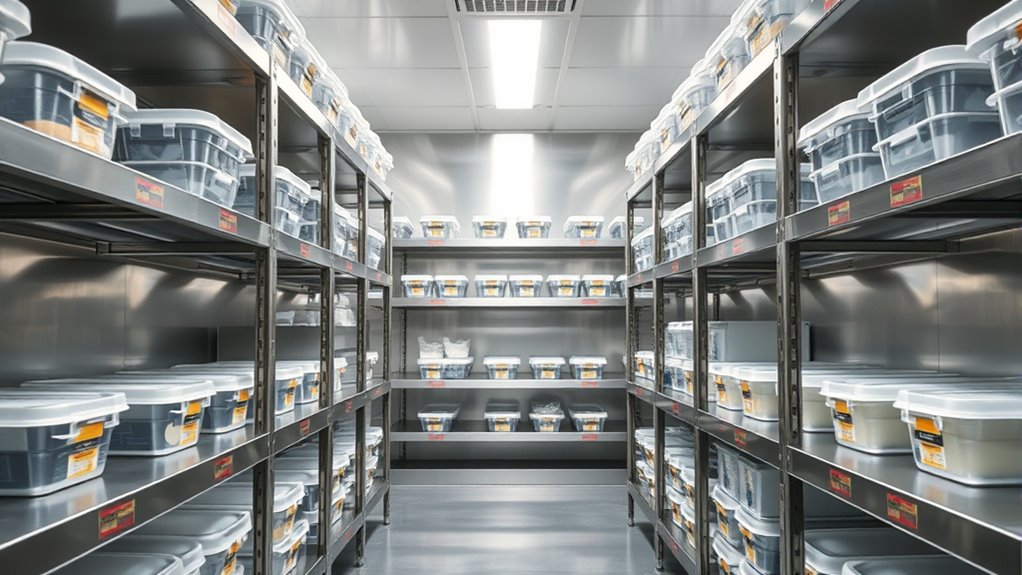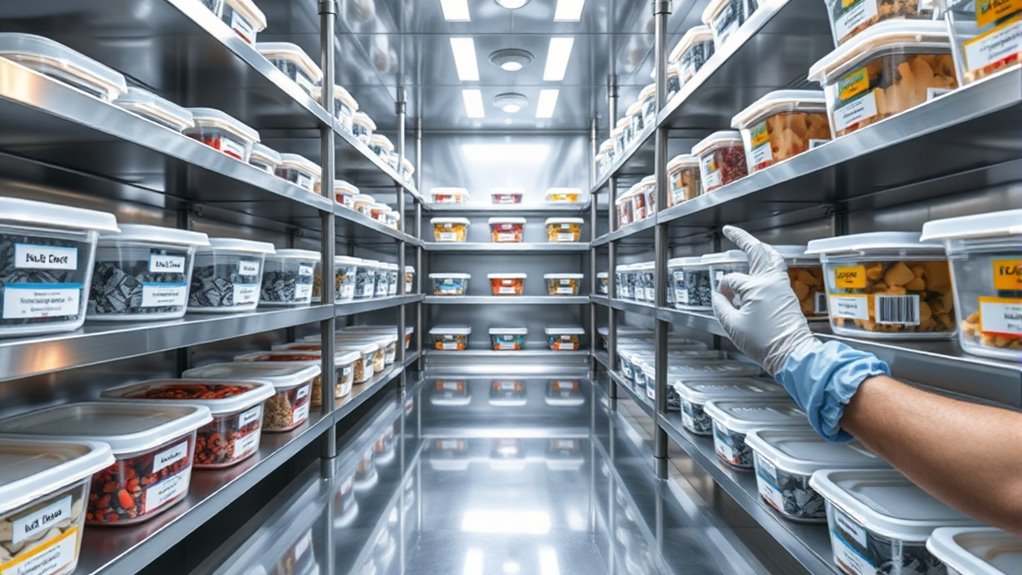To design storage that avoids cross-contamination, you should organize spaces with clear separation of raw and cooked foods, placing raw meats on lower shelves and ready-to-eat items higher. Use durable, easy-to-clean surfaces and sealed containers to prevent leaks and contact. Establish designated pathways for staff to reduce crossing paths. Proper labeling and color-coded tools also help maintain order. Keep learning how thoughtful storage design keeps food safe and contamination-free.
Key Takeaways
- Allocate separate storage zones for raw, cooked, and ready-to-eat foods to prevent cross-contact.
- Use durable, non-porous materials for shelves and containers to facilitate thorough cleaning and sanitation.
- Arrange storage with raw meats on lower shelves and ready-to-eat items on higher shelves to prevent drips and contamination.
- Implement designated pathways for staff to minimize cross-traffic and accidental contact between different food categories.
- Regularly train staff on proper storage practices and ensure tools and equipment are dedicated to specific food types.

Have you ever considered how your storage setup might contribute to cross-contamination? Proper storage design is essential in preventing the spread of bacteria and allergens. One of the key elements is ensuring that food contact surfaces are kept clean and separate. These surfaces, which include shelves, containers, and utensils, can harbor pathogens if not properly maintained. When designing your storage, think about how food contact surfaces are arranged and cleaned regularly. Using smooth, non-porous materials makes cleaning easier and reduces bacteria buildup. Also, assign specific surfaces for different types of food—raw meat, produce, dairy—so cross-contact is minimized. It’s important to train staff to recognize the importance of cleaning and sanitizing these surfaces frequently.
Proper storage design keeps surfaces clean, separate, and easy to sanitize to prevent cross-contamination.
Another critical aspect is storage temperature control. Different foods require specific temperatures to stay safe. Cold foods like dairy and raw meats should be stored at or below 40°F (4°C), while frozen items should be kept at 0°F (-18°C) or lower. When designing your storage, make sure there’s a clear separation between these temperature zones. This prevents temperature abuse that could lead to bacterial growth. Regularly monitor and record storage temperatures to catch any deviations early. Implementing a system that alerts you to temperature fluctuations helps maintain food safety. Proper temperature control not only preserves food quality but also reduces the risk of cross-contamination caused by spoilage or bacterial proliferation.
Think about the physical layout of your storage space. Place raw meats on the lowest shelves to avoid drips contaminating other foods. Keep ready-to-eat items, like salads or cooked foods, on higher shelves, away from raw ingredients. Use sealed containers for leftovers and prepped ingredients to prevent spills and cross-contact. Design your storage to facilitate easy cleaning—avoid clutter and ensure there are no hard-to-reach areas where bacteria can hide. Label shelves and containers clearly, which promotes organized storage and helps staff quickly identify and handle different food types appropriately.
Finally, consider the flow of movement within your storage area. Minimize cross-traffic between raw and cooked or ready-to-eat foods to reduce contamination risks. Staff should have designated paths and use separate tools when handling different food categories. Regular training on these principles keeps everyone aware and diligent. By paying close attention to food contact surfaces, temperature control, and overall layout, your storage setup can considerably reduce cross-contamination risks, safeguarding both your food safety and your reputation. Additionally, incorporating proper storage practices can help streamline your operations and ensure compliance with safety standards.
Frequently Asked Questions
How Often Should Storage Areas Be Inspected for Contamination Risks?
You should inspect storage areas at least weekly to guarantee contamination prevention and adherence to storage protocols. Regular inspections help identify potential contamination risks early, allowing you to take corrective actions promptly. Keep an eye on cleanliness, proper segregation of items, and storage conditions. Frequent checks maintain a safe environment, reduce cross-contamination chances, and ensure your storage practices consistently meet safety standards.
What Materials Are Best for Antimicrobial Storage Containers?
Did you know that choosing the right materials can reduce contamination risks by up to 50%? For antimicrobial storage containers, look for those made from antimicrobial materials like copper, silver, or certain plastics infused with antimicrobial agents. Guarantee the storage container compatibility with your products to prevent chemical reactions and maintain safety. Using these materials helps you effectively minimize cross-contamination and keep your storage areas safer.
How Can Staff Be Trained Effectively on Storage Hygiene?
You should conduct regular staff training on hygiene protocols, emphasizing proper storage practices and cross-contamination prevention. Use hands-on demonstrations and visual aids to reinforce key points, and encourage questions to make sure understanding. Implement ongoing assessments and refreshers to keep everyone updated on best practices. Clear documentation and easy access to hygiene guidelines also help staff stay informed and consistent, ultimately maintaining a safe, contamination-free storage environment.
Are There Specific Storage Guidelines for Allergen-Free Zones?
Think of allergen-free zones as your kitchen’s sacred ground. You must follow strict storage guidelines, ensuring allergen segregation by keeping these products separate from others. Use clear storage labeling to identify these areas easily, preventing mix-ups. Regularly check that these zones stay uncontaminated. By maintaining strict adherence to allergen segregation and clear labeling, you protect vulnerable customers and uphold safety standards effectively.
What Technologies Can Monitor Cross-Contamination in Storage Areas?
You can use sensor technology for real-time monitoring of cross-contamination in storage areas. These advanced sensors detect airborne allergens, moisture, or residue, providing instant alerts if contamination occurs. By integrating this technology, you actively safeguard allergen-free zones, ensuring compliance and safety. Regularly checking sensor data helps you respond quickly to potential issues, maintaining the integrity of storage spaces and preventing cross-contact between different food products.
Conclusion
To prevent cross-contamination, you must prioritize proper storage practices. Keep raw meats separate from ready-to-eat foods and use clearly labeled, dedicated containers. Did you know that improper storage can lead to foodborne illnesses, affecting over 48 million people annually in the US? By implementing these simple but effective storage strategies, you considerably reduce health risks and ensure safer food handling. Stay vigilant and keep cleanliness at the forefront to protect yourself and others.








